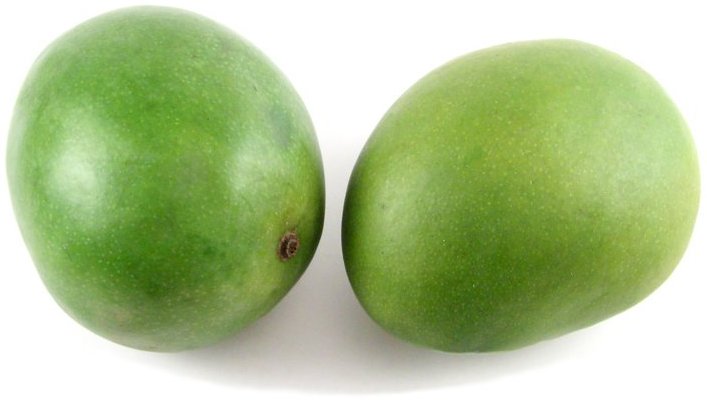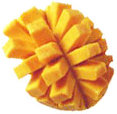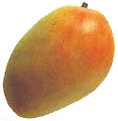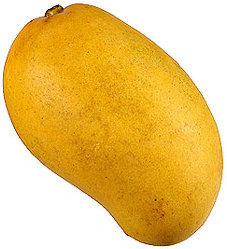

Mango

Mangifera. (From mangas, the Hindi name for the fruit, and Latin ferre, to bear.) MANGO. Anacardiaceae. About 35 species of andromonoecious trees. Leaves simple, alternate, exstipulate. Inflorescence a terminal or axillary panicle; pedicels articulate; calyx 4-5-lobed; petals 4-5, overlapping, sometimes with glandular ridges, usually free; disc usually extrastaminal, often lobed, notched or furrowed, sometimes obsolete in male flowers; stamens 1-12, usually 5, sometimes with staminodes, anthers dorsifixed; ovary superior, glabrous, unilocular, style eccentric or lateral, stigma simple. Fruit a fleshy, resinous, drupe; exocarp coriaceous, endocarp fibrous; seeds 1, sometimes polyembryonic, testa free. India to S China and Solomon Islands, naturalised N Australia. Z10. CultivationMangifera indica was grown in India for 4000 years; from there it spread to Southeast Asia, Africa and South America. It now grows almost everywhere in the tropics and frost-free sub-tropics. India is the largest producer: nine million tonnes on a million hectares. The chief exporters, however, are Mexico and Mali. Mango is the most popular fruit in the Orient. Ripe fruit is eaten for dessert, or is canned or juiced: pickles and chutney are made from unripe fruit. The edible part contains 15% sugars, 0.5% protein and significant amounts of vitamins A, B and C. The optimal climate for mango ranges from monsoon tropics to the frost-free sub-tropics, with a marked dry (or cool) season of at least three months. Light frost kills young trees, but older trees tolerate some frost when dormant. The optimum temperature is 25ºC. The dry season of equatorial regions is too unreliable for commercial cultivation of mango. Water needs depend on soil, climate and cultivar. About 1200mm, well spaced over eight months, is adequate on soil of good water-holding capacity: otherwise, irrigation must be supplied. Low humidity and strong wind unduly raise Ep and lead to severe wilting. A very fertile soil is not needed, but very poor and shallow land is unsuitable. A pH of 6-7 is ideal. At a higher pH, deficiences of trace elements appear and will reduce growth and fruit production. A light slope furthers drainage, but steep slopes are unsuitable. 
There are hundreds of cultivars in India and dozens more elsewhere. Good descriptions are often lacking. The monoembryonic cultivars from India and Florida are generally highly coloured and fibreless. ‘Alphonso’, ‘Mulgoa’, ‘Neelum’ are well known for their high quality. ‘Alphonso’ prefers a humid climate and has small fruit (average 240g), the other two are more at home in a drier climate, have bigger fruit and mature later. The best Florida cultivars are – from early to late maturing – ‘Irwin’, ‘Haden’, ‘Tommy Atkins’, ‘Kent’, ‘Zill’ and ‘Keitt’. Polyembryonic cultivars come from Indochina (‘Cambodiana’), Indonesia (‘Golek’ and ‘Arumanis’), the Philippines (‘Carabao’), Hawaii (‘Momi K and ‘Pope’), the West Indies (‘Amélie’ and ‘Julie’) and West Africa (‘Améliorée du Cameroun’). Some cultivars are self-incompatible and must be planted in mixed stands, but self-compatible cultivars also benefit from cross-pollination. Seeds are sown fresh. The taproot extends to 5m below the surface unless checked by hardpans. Seedlings bear fruit after seven years but grafted trees may bloom in the third year. However, it is better to remove all panicles during the first four years. Bloom is initiated by drought or cold. The flowers are male or perfect, but few of the latter develop into mature fruit. Alternate bearing occurs frequently due to rain, mineral deficiencies and other factors. Bonfire smoke and a 1% KNO3 spray promote flowering. The general practice is to graft on polyembryonic stock. Well-known rootstocks are cultivars ‘Pahutan’, ‘Goa’, ‘Golek’, ‘Arumanis’, ‘Carabao’, ‘Pico’, ‘Sabre’, ‘Carotte’ and ‘Maison-rouge’. The seeds are washed, dried in shade, and sown 5cm deep, convex side up, at 15 x 30cm. Germination of peeled seeds takes 18 days, or one month with the seed coat on. The cotyledons remain in the soil, the shoot is tinged with red. Hybrids must be removed; these seedlings are always at the micropylar end. Transplanting at 40 x 100cm takes place when seedlings are 10cm high; care is taken that roots and stems are not damaged. Stocks should be fed and irrigated frequently; weeds, pests and diseases must be controlled. Modern practice is to plant the seedlngs in 15cm-deep bags. Approach grafting on six-month to one and a half year old stock is common in India; elsewhere budding is preferred as it takes less labour. The regular practice in Florida is chip budding on very young stocks. Cuttings, cut layers and stooling are possible methods of propagation. 
Seedling trees are spaced at 10 x 10m or wider; grafted trees at 10 x 8m. If planted closer, thinning out will be required later. As this is usually delayed, or omitted, it is better to plant wide and grow an intercrop of banana or papaya for six years. Where strong wind may occur, a shelterbelt will be needed. Holes of 40cm³ are made on permeable soil and manure (50kg) and rock phosphate (1kg) are mixed with the soil before filling. Initial irrigation may be necessary. Weeds must be kept under control in the young orchard, but not by cover crops, which would dry out the soil. After some years the trees will shade out the weeds. Good drainage is essential. Young trees must be irrigated every two weeks during drought. Older trees need irrigation only when in fruit. Feeding with NPK 4:1:4 at 750g N per 12-year-old tree is advised in India; 1000kg NPKMg 10:3:12:6 per ha was needed in Venezuela. Trace elements should be added when necessary. Leaf analysis showed that a minimum of 15ppm Zn is required. Only light pruning is needed for young trees. Older trees can be rehabilitated by top grafts. Anthracnose, caused by Colletotrichum gloeosporioides variety minor, results in leaf spot and fruit rot. Control in the field can be achieved by frequent sprays of appropriate fungicides. ‘Tommy Atkins’, ‘Kieitt’, ‘Améliorée du Cameroun’ and ‘Alphonso’ are resistant. Canker, gummosis, powdery mildew and storage rot are also caused by fungi. The cause of malformation is uncertain, but a 200ppm spray of NAA cures it. A hopper attacks mango blossom in India; sooty mould develops on their honey-dew. Other pests are scales, fruit flies and nematodes. An average yield in on-years is 500 fruits per tree. The fruit is harvested when the colour changes, or after some fruit has dropped. Picked fruit is immersed in water at 52ºC for five minutes for protection against anthracnose. Exposure to sunlight is harmful. Then the fruit is cooled at 15ºC, graded, sized, packed and stored or transported at 9ºC and 85-90% relative humidity. For marketing, the fruit is ripened at 16-21ºC for five days. In temperate regions, grow in a lofty hot glasshouse (minimum temperature 16-18ºC) in a sandy, loam-based medium. Keep evenly moist but not constantly wet. Maintain moderate humidity.  Mangifera caesia
Mangifera caesia
Tree to 35m. Trunk occasionally buttressed, bark grey-brown, fissured. Leaves coriaceous, elliptic, obovate, ovate, ovate-oblong or lanceolate, cuneate, short-acuminate or obtuse; petiole flattened, 2-6cm. Inflorescence a terminal panicle, pyramidal, 15-75cm, puberulent; bracts ovate-lanceolate or elliptic; disc pulvinate; stamens 5, 3-4 infertile; ovary subglobose. Fruit rough, brown to yellow-brown or pale green, ellipsoid, to 19 x 10cm. Sumatra, Malay Peninsula, naturalised elsewhere in Malaysia. Mangifera foetidaTree to 40m. Bark green or red-brown, rough, fissured or scaly. Leaves 14-35 x 6-16cm, stiff, coriaceous, oblanceolate to elliptic, obtuse, sometimes emarginate, cuneate or attenuate, dark green, nerves raised above, prominent beneath. Panicles mostly terminal, pyramidal, glabrous, dense, 10-40cm; bracts ovate-lanceolate, to 5mm; flowers pink to dark red; calyx 5-lobed, ovate; petals narrowly lanceolate, to 9mm, 3-ridged; disc pulvinate; stamens 5; ovary subglobose. Fruit yellow or grey-green. Spring. Indochina, Malaysia. Mangifera indicaTree to 30m. Bark grey, fissured. Leaves to 30 x 7cm, sub-coriaceous or papery, oblong-elliptic or oblong-lanceolate, acuminate or acute; petiole 2-6cm. Panicles tomentose; bracts triangular, to 5mm; sepals 5, ovate; petals 5, oblong-ovate to obovate, ridged; disc thick, papillose; stamens 5, 1 fertile; ovary obliquely ovoid or subglobose; style to 2mm, rudimentary or absent in male flowers. Fruit variably ovoid-oblong, 4-25 x 1-10cm, variably yellow, green or red, flesh yellow, endocarp thick, fibrous. Burma, widely naturalised throughout tropical Asia. Large numbers of cultivars exist locally. The following are grown in the US: ‘Carrie’: fruit medium-sized. ‘Edgehill’: fruit small to medium. ‘Glenn’: fruit large. ‘Haden’: fruit very large. ‘Irwin’: fruit medium, seed small. ‘Julie’: fruit medium. ‘Keitt’: fruit medium to large. Mangifera x odorata(Mangifera indica x Mangifera foetida.) Tree to 35m. bark grey, smooth or fissured. Leaves to 35 x 10cm, coriaceous, elliptic-lanceolate or lanceolate, acuminate or acute, cuneate or obtuse; petiole 5-7cm, grooved above, convex beneath. Panicles terminal or sometimes in upper leaf axil, pyramidal, 12-50cm, sometimes puberulous; bracts ovate to ovate-oblong, 1-2mm; calyx lobes ovate to elliptic, rarely lanceolate; petals 5, exterior pale yellow, becoming red; stamens 5, 1 fertile; ovary subglobose; style eccentric, minute in male flowers. Fruit dark green, obliquely ovoid to broadly ellipsoid, to 13 x 10cm, flesh yellow. Origin unknown, naturalised Malaysia.
|
Home
Grow Herbs
Grow Nuts
Grow Vegetables
Cyberian Index
If you like this website and want one of your own contact
Cyberian All information correct at
time of publication and open to updates as necessary. No part of this website,
or its vectors, may be produced in any shape or form, using any type or design
of medium, system, equipment or otherwise without the prior written consensual
notice of the Cyberian. Any breach of these requirements will result in the
appropriate action. If in doubt, e-mail contact is recommended.
Some components of this website were obtained as open-source software and are
used in the same non-profit manner on this website.